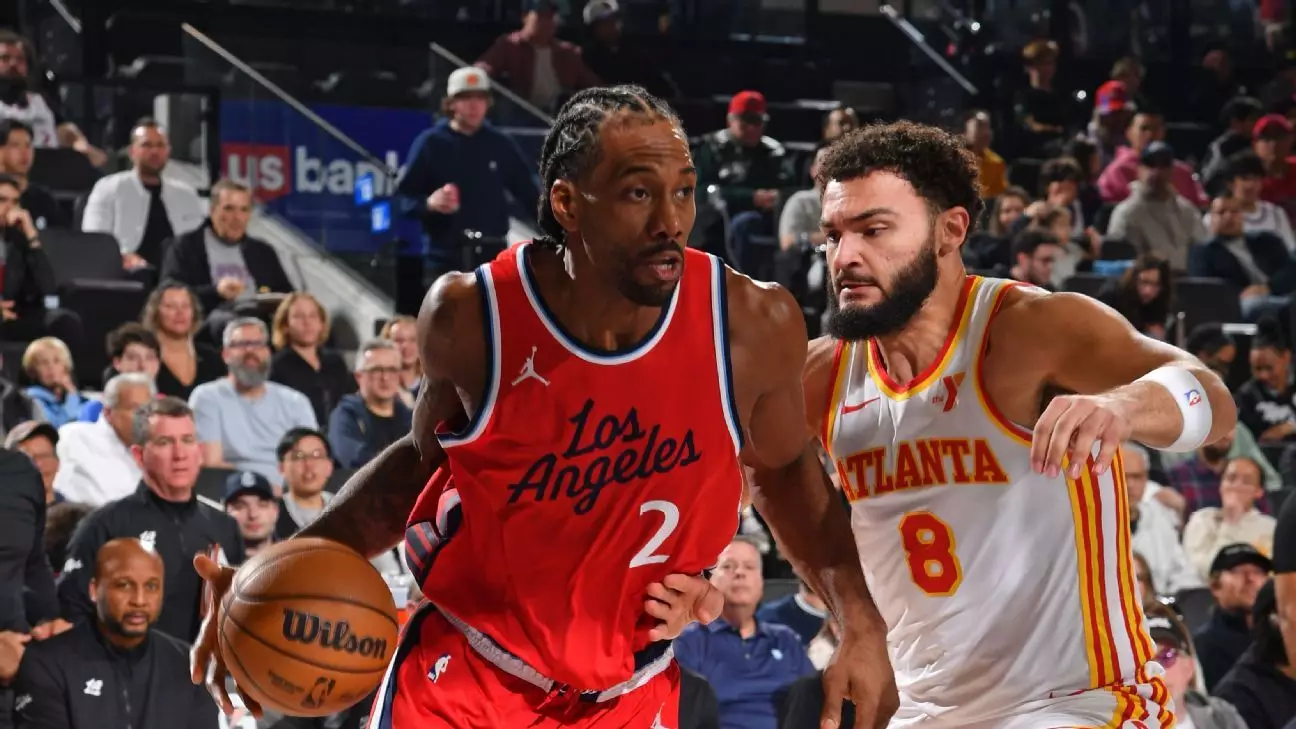Kawhi Leonard’s return to the court after an extensive hiatus has marked a pivotal moment not only for himself but also for the LA Clippers franchise. Having endured an arduous 253 days away from competitive play due to knee issues, Leonard’s presence signifies hope and resilience. As he made his season debut against the Atlanta Hawks, the narrative surrounding his return extends beyond mere statistics—it encapsulates the trials an athlete undergoes during rehabilitation, the mental fortitude required to bounce back, and the overall impact on a team striving for success.
Leonard’s statement that “playing basketball was the easy part” speaks volumes about the psychological and physical battle athletes face during prolonged injuries. For professional players, the physical aspect of the sport is secondary to the mental hurdles posed by recovery. Leonard emphasized that the most challenging moments came while he was sidelined—experiencing frustration from not being able to contribute on the hardwood and watching his teammates from the sidelines. It is evident that an athlete’s journey is laden with moments of doubt and uncertainty, which can be far more grueling than the physical demands of the game itself.
In Leonard’s case, the inflammation in his surgically repaired right knee was a significant hurdle. Missing the team’s training camp, preseason, and the opening months of the regular season posed questions not only about his physical condition but also about his long-term future with the team. Each day of rehab is marred with anxiety about recurring injuries and performance levels. The endurance required to overcome such mental and physical challenges often defines a player’s legacy.
When Kawhi took the court for the first time since April, fans welcomed him with open arms, showcasing the admiration and support he holds within the Clippers community and the broader basketball landscape. Scoring 12 points in just 19 minutes, his early impact may not have been quantifiably impressive, but it established a renewed sense of optimism for fans and players alike. Leonard’s calculated approach during his limited minutes hinted at a larger strategy in the works—a phased re-integration into the team’s structure.
Head coach Ty Lue remarked on Leonard’s presence, noting its beneficial impact on the overall team dynamics. Leonard’s ability to draw defenders and create opportunities for teammates was immediately palpable, as highlighted by guard Norman Powell’s statement underscoring Leonard’s capacity to energize and elevate his fellow players on the offensive end. Such dynamics demonstrate why Leonard is revered not just as a scorer but as a facilitator—a player whose presence can reshuffle defensive strategies, granting his teammates newfound freedoms.
Leonard’s cautious re-entry into regular-season play reflects a broader strategy of managing players’ physical burdens, especially in a league that sees athletes subjected to grueling schedules. The Clippers’ decision to treat Leonard’s return like a “preseason game” reveals their commitment to preserving his long-term health while still vying for success in the moment. It’s a high-stakes balancing act, especially in a competitive environment where every win counts, yet preserving the health of a franchise-altering player is paramount.
As the Clippers scored a decisive 131-105 victory over the Hawks, the victory served as a reminder of the team’s deep bench, with multiple players achieving double figures in scoring. The cohesion and teamwork displayed emphasize that while individual stars like Leonard shine, championships are built through collective efforts. Observing Leonard’s integration into the flow of the game will be crucial in the coming months, as fans and analysts alike eagerly chart his progress on the court.
Leonard’s journey toward full recovery is still evolving, as evidenced by his reflections captured in a social media video. It’s evident that the healing process is fraught with uncertainty, encompassing both physical readiness and mental stability. He remains cautious, emphasizing the unpredictability of recovery timelines. Such honesty from an elite athlete demystifies the common misconception that recovery is linear and fully predictable.
The weight of expectations looms large, particularly given Leonard’s injury history with the Clippers, including his previous meniscus tear and ACL injury. It’s an ongoing narrative, one marked by potential and peril alike, as the franchise looks toward a future that hinges on the health and productivity of its star player. As Leonard focuses on further integrating himself into the game, both he and the Clippers will concurrently navigate the complexities that arise from high aspirations and the quest for consistent performance.
As Leonard endeavors to reclaim his form, fans must embrace a journey defined not solely by immediate outcomes but by a long-term vision that encompasses growth, resilience, and the intrinsic love of the game—the very elements that make sports enthralling and human.


Leave a Reply